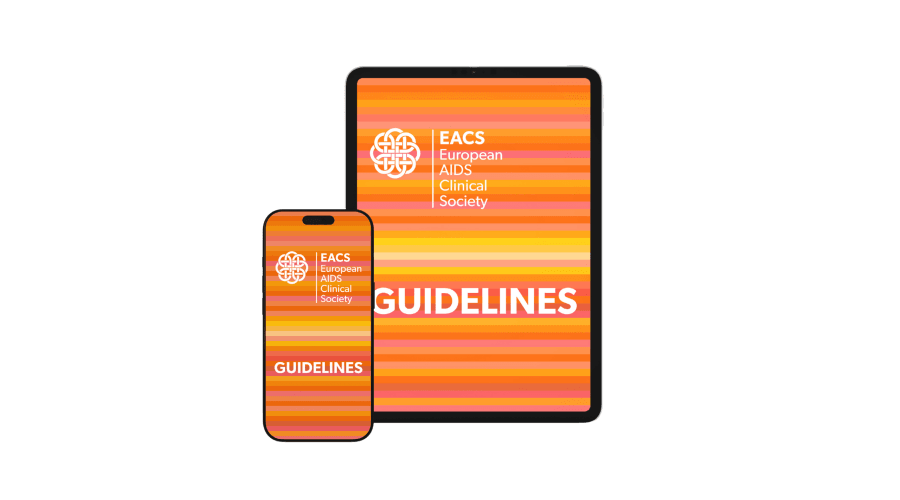 Credit: EACS
Credit: EACSThe European AIDS Clinical Society issued updated guidelines at its 20th European AIDS Conference(EACS 2025) in Paris last week, making new recommendations on infant feeding and diagnosis and management of obesity in people with HIV.
Antiretrovirals for treatment and prevention
The updated guidelines make no new recommendations on starting or changing treatment, except in relation to people who acquire HIV when using PrEP. In this case, the updated guidelines recommend that dual antiretroviral therapy (ART) regimens should be avoided. For people who acquire HIV when taking long-acting cabotegravir, treatment should start with boosted darunavir and two active nucleoside reverse transcriptase inhibitors.
For PEP (post-exposure prophylaxis), the guidelines now recommend bictegravir/emtricitabine/tenofovir alafenamide (Biktarvy) as the preferred regimen.
The guidelines differ from others by recommending an HIV viral load test before starting PrEP, especially if a high-risk exposure has taken place in the previous six weeks. In contrast, British and US Centers for Disease Control and Prevention guidelines on PrEP recommend the use of a combined antibody/antigen test in all circumstances except suspected seroconversion illness, where a viral load test should be used alongside a combined antibody/antigen test. The World Health Organization recommends the use of a rapid antibody test before starting PrEP.
Infant feeding
A revised section on infant feeding recommends that breastfeeding should be supported if women who are fully adherent and virally suppressed on continuous ART want to breastfeed. As the risk of transmission through breastfeeding increases with a longer duration of breastfeeding, breastfeeding should ideally be limited to no more than six months.
The guidelines recommend that accessible, clear information relating to very low but non-zero risk of transmission during breastfeeding should be provided to all pregnant women, ideally well before delivery, so that women can make a shared decision with their care team.
Monthly monitoring of maternal viral rebound is recommended to rapidly identify viral rebound. If maternal viral load rises above 50 copies/ml during breastfeeding, alternative feeding options should be used, breastfeeding should be interrupted or stopped, and PEP should be considered for the infant.
Although mixed feeding may potentially raise the risk of HIV transmission, the use of formula milk may be considered to help establish breastfeeding or during the transition from breastfeeding to formula feeding, during mastitis or if the infant experiences gastroenteritis. Mixed feeding with breast milk and solids raises the risk of HIV transmission and should be avoided.
Co-morbidities
The guidelines make a new recommendation on screening for sleep disorders. Doctors should ask people with HIV “how is your sleep?” every two years as well as after switching treatment. If patients report abnormal sleep patterns, the doctor should carry out a sleep disorder risk screen for insomnia, excessive daytime sleepiness and obstructive sleep apnoea, and identify modifiable risk factors.
An annual substance use screen is also recommended, as is motivational interviewing to identify alcohol use disorder and motivations to cut down or stop drinking.
The updated guidelines incorporate a new definition of obesity and give guidance on how to diagnose the condition. The authors emphasise that obesity is a condition caused by excess fat and that body mass index measurements should be supplemented by measurements of total body fat by DEXA scan or abdominal fat by waist circumference or waist-to-hip ratio.
Individuals who have excess body fat but no organ dysfunction are considered to have subclinical obesity. Those with excess body fat and organ dysfunction have clinical obesity. Examples of organ dysfunction linked to excess fat include:
- heart failure, atrial fibrillation, recurrent deep vein thrombosis
- chronic, severe knee or hip pain due to bearing excess weight
- lower limb lymphoedema (build-up of lymphatic fluid in the legs) causing chronic pain, reduced range of motion
- infrequent menstruation or irregular cycle, lack of egg release at menstruation, polycystic ovary syndrome
- recurrent urinary incontinence
- substantial, age-adjusted limitations of daily living
- breathlessness or wheezing.
Management of obesity should focus on lifestyle measures (diet and physical activity) and the use of GLP-1 receptor agonists such as semaglutide or bariatric surgery where indicated and available.
By Keith Alcorn
References
EACS Guidelines session. 20th European AIDS Conference, Paris, special session, 2025.
Full list of updates to the EACS guidelines: eacs.sanfordguide.com/en/about/changes-v12-1-to-v13
EACS 2025 guidelines: eacs.sanfordguide.com
All official news reporting from EACS 2025
SEE ALSO:
Source : EACS 2025
Related HIV and Co-Infections News
Get involved
Are you living with HIV/AIDS? Are you part of a community affected by HIV/AIDS and co-infections? Do you work or volunteer in the field? Are you motivated by our cause and interested to support our work?
Subscribe
Stay in the loop and get all the important EATG updates in your inbox with the EATG newsletter. The HIV & co-infections bulletin is your source of handpicked news from the field arriving regularly to your inbox.
